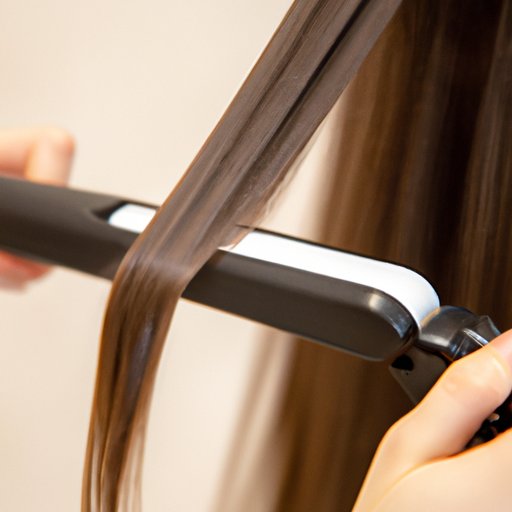Introduction
Many people struggle with achieving the perfect curls using a flat iron. The process can seem daunting, and the results are often underwhelming. However, with the right techniques and tools, curling hair with a flat iron can be a breeze. This article will provide a step-by-step guide on how to effectively curl hair with a flat iron, offer tips for achieving different curl types, discuss hair types and techniques, explain the importance of proper heat settings, identify the best tools for the job, and provide maintenance tips to keep your curls looking great.
Step-by-Step Guide
Before beginning the curling process, start with clean, dry hair. Apply a heat protectant to reduce damage. Divide your hair into small, manageable sections. Starting from the bottom, clamp the flat iron around the hair about an inch from the scalp, twist the flat iron 180 degrees, and slowly glide the flat iron through your hair to the ends. Release the hair and move to the next section.
For loose curls, use wider sections of hair and glide the flat iron through the hair quickly. For tighter curls, use smaller sections and glide the flat iron more slowly. Experiment with the twisting motion to achieve the desired curl.
Hair Types & Techniques
Different hair types require different techniques for curling. For thick hair, use smaller sections and slow down the gliding motion. For thin hair, use wider sections and glide the flat iron quickly. For coarse hair, turn up the heat, and for curly hair, use a lower heat to avoid damage.
Adjust the technique based on the desired result. For beachy waves, create curls in alternating directions. For natural curls, use a slower gliding motion. For tighter curls, create smaller, tighter twists, and for looser curls, create wider twists.
Heat Settings
Using the proper temperature setting is important to avoid hair damage. Generally, thick, coarse, or curly hair requires higher temperatures, while thin hair requires lower temperatures. For loose curls, use a lower temperature, and for tighter curls, increase the heat.
Adjust the temperature setting during the curling process as needed. If you notice your hair is becoming too damaged or frizzy, lower the temperature. If you’re not getting the desired curl, increase the temperature slightly.
Best Tools
Choosing the right flat iron is key to achieving the perfect curl. Consider the size and shape of the flat iron based on your hair length and desired curl type. Look for flat irons with ceramic or tourmaline plates for even heat distribution and reduced damage.
For budget-friendly options, consider Conair InfinitiPRO or Remington Wet2Straight. For mid-range options, consider CHI or BaBylissPRO. For high-end options, consider GHD or Dyson.
Creating Different Curl Types
Loose beachy waves can be achieved by creating alternating curls in different directions. Tight curls can be created by using smaller sections, a higher temperature, and a slower gliding motion. Natural curls can be achieved by using a slower gliding motion and twisting the flat iron in different directions. Experiment with twisting the hair in different directions to create a unique and tailored curl.
Visual aids, such as YouTube tutorials or pictures, can be helpful in understanding the technique required to achieve specific curl types.
Maintenance
Maintaining your curls is important for their longevity. Avoid washing your hair too frequently and consider using dry shampoo in between washes. Apply a leave-in conditioner to keep the curls moisturized. Use a diffuser on your blow dryer to dry the curls gently. Avoid brushing the curls and instead use a wide-tooth comb to detangle.
Product recommendations for maintaining your curls include Living Proof Curl Defining Styling Cream, Bumble and Bumble Curl Anti-Humidity Gel-Oil, and Ouidad Advanced Climate Control Featherlight Styling Cream.
Conclusion
Curling hair with a flat iron doesn’t have to be a daunting task. With the right techniques, tools, and heat settings, achieving perfect curls can be easy. Experiment with different curl types and techniques to find the one that works for you. With the proper maintenance, your curls can look great for days to come.
